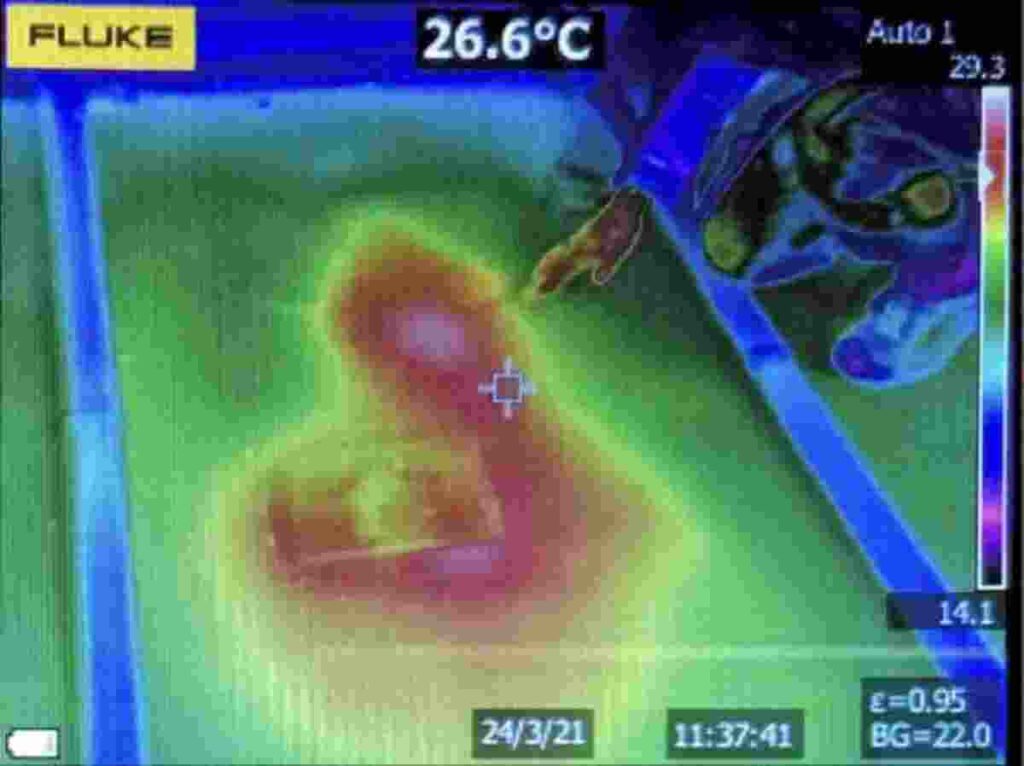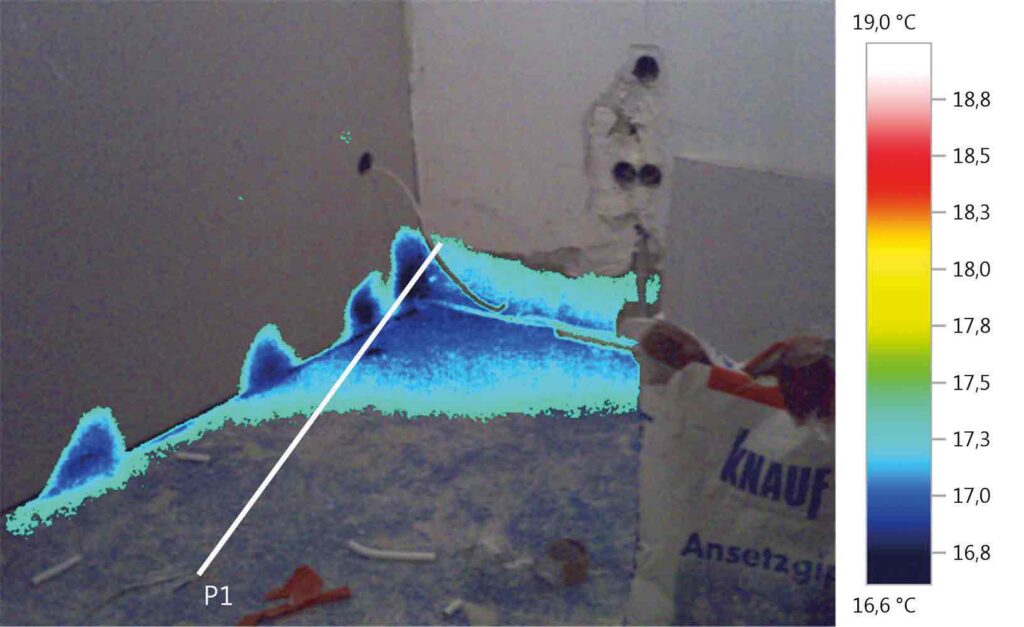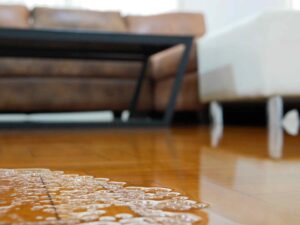Blogs
The Role of Thermal Imaging in Water Damage Detection in Plano
Welcome to the dynamic landscape of Plano, Texas, where the battle against water damage is an ever-present concern for homeowners. In a city where climate variations keep us on our toes, the need for effective detection methods is paramount. Enter thermal imaging – a cutting-edge technology that goes beyond what meets the eye. This article delves into the game-changing role of thermal imaging in spotting water damage early on, preventing structural nightmares, and ensuring your Plano home remains resilient in the face of unexpected moisture challenges. In this blog post, Intensa Dry Water Damage Restoration helps to explore how this innovative tool is reshaping the way we safeguard our homes.
Understanding Thermal Imaging

Thermal imaging, also known as infrared thermography, utilizes infrared radiation to create detailed images of temperature variations in an object or space. This technology enables professionals to identify anomalies not visible to the naked eye, making it a valuable tool in the field of water damage detection. Understanding thermal imaging is integral to comprehending the intricacies of the fire restoration process. Thermal cameras provide invaluable insights into the extent of heat and fire damage, guiding restoration professionals in assessing structural integrity. By capturing temperature variations, thermal imaging aids in identifying hidden hotspots, ensuring a thorough and accurate evaluation of fire-damaged areas. This understanding of thermal imaging technology enhances the precision and efficiency of the fire restoration process, allowing for a more targeted and effective restoration strategy.
Thermal imaging, also known as infrared thermography, is a revolutionary technology that captures and visualizes temperature variations in objects or environments. By detecting infrared radiation emitted by different surfaces, thermal cameras create detailed images, allowing professionals to identify anomalies not visible to the naked eye. In applications ranging from electrical inspections to medical diagnostics, understanding thermal imaging provides a powerful tool for non-invasive analysis, revealing hidden insights and enabling proactive measures in various fields.
Early Detection of Water Intrusion
One of the primary advantages of thermal imaging is its ability to identify water intrusion at its early stages. Water damage often begins behind walls, ceilings, or within building materials, making it challenging to detect without invasive measures. Thermal cameras can detect temperature differences caused by moisture, allowing professionals to pinpoint potential problem areas before visible signs of damage emerge.
Early detection of water intrusion is paramount in preserving the integrity of structures. Traditional methods often fall short, making thermal imaging a game-changer. By capturing temperature variations caused by moisture, thermal cameras can identify potential issues hidden behind walls or ceilings. This non-invasive approach allows professionals to pinpoint water damage at its inception, preventing extensive structural damage and mitigating the risk of mold growth. Early intervention based on thermal imaging findings translates into more effective and efficient remediation strategies, safeguarding properties in the long run.
Enhanced Accuracy in Moisture Detection
Traditional moisture detection methods, such as moisture meters, may provide localized information but can be limited in their scope. Thermal imaging, on the other hand, offers a broader perspective by revealing the extent of moisture infiltration across surfaces. This comprehensive view enables technicians to assess the full impact of water damage and formulate targeted remediation plans.
Thermal imaging provides enhanced accuracy in moisture detection by offering a comprehensive view of water infiltration. Unlike traditional moisture meters with localized readings, thermal cameras reveal the full extent of moisture distribution across surfaces. This detailed perspective ensures a more precise assessment of water damage. Professionals can identify not only the presence of moisture but also its severity and spread, allowing for targeted and effective remediation strategies. The technology’s ability to capture a broader picture of moisture-related issues contributes to a more thorough and reliable evaluation, guiding practitioners towards more informed decision-making in the restoration process.
Non-Invasive Inspection
Unlike destructive methods that involve tearing down walls or removing flooring, thermal imaging is a non-invasive inspection technique. This means that professionals can identify water damage without causing additional harm to the structure. This aspect is particularly beneficial in minimizing disruption and reducing the overall cost of repairs.
Non-invasive inspection through thermal imaging is a breakthrough in detecting water damage without destructive measures. Unlike traditional methods that involve tearing down walls or removing flooring, thermal cameras capture temperature variations, pinpointing moisture intrusion behind surfaces. This non-intrusive approach not only prevents additional structural damage but also minimizes disruption and repair costs. By offering a detailed view of hidden issues, thermal imaging ensures thorough assessments, allowing professionals to address water damage early on, saving both time and resources while maintaining the integrity of the inspected structures.
Enhanced accuracy in moisture detection through thermal imaging serves as a cornerstone in optimizing water damage cleanup and mitigation services. By precisely identifying the extent and distribution of water infiltration, professionals can develop targeted strategies for efficient cleanup efforts. This accuracy allows for a more effective removal of affected materials and reduces the risk of overlooking hidden moisture pockets. As a result, water damage mitigation services equipped with thermal imaging technology can ensure thorough remediation, preventing potential issues that may arise if undetected moisture is left untreated.
Mapping and Visualizing Moisture Patterns

Thermal imaging not only detects the presence of moisture but also provides a visual representation of its distribution. By mapping moisture patterns, technicians can identify the source of the intrusion and track its progression. This detailed insight allows for more accurate decision-making in terms of prioritizing repairs and implementing preventative measures.
Mapping and visualizing moisture patterns through thermal imaging provide invaluable insights into the extent and distribution of water damage. This technology goes beyond merely detecting moisture, offering a clear, visual representation of affected areas. This allows for precise identification of the source, aiding professionals in developing targeted strategies for effective remediation.
- Thermal imaging offers visual representation of moisture patterns in affected areas.
- Comprehensive mapping reveals the extent and distribution of water damage.
- Clear insights into moisture patterns aid in early detection and prevention.
- Precise identification of the source allows for targeted remediation strategies.
- Visual data assists professionals in making informed decisions for effective repairs.
- The technology’s ability to map and visualize moisture patterns enhances the overall efficiency of water damage assessment and mitigation efforts.
Mitigating Mold Growth
One of the most significant risks associated with water damage is the potential for mold growth. Mold thrives in damp environments, and its presence can exacerbate health issues for occupants. Thermal imaging aids in the early detection of moisture, preventing the conditions conducive to mold growth. This proactive approach not only safeguards the structural integrity of the property but also protects the health and well-being of its occupants.
Mitigating mold growth is a critical aspect of water damage prevention, and thermal imaging plays a pivotal role in this process. By detecting moisture at its early stages, thermal cameras help create conditions unfavorable for mold development. Swift identification and remediation of water intrusion, guided by thermal imaging insights, prevent the damp environments that mold thrives in. This proactive approach not only safeguards structural integrity but also protects occupants from potential health hazards associated with mold. Thermal imaging’s ability to contribute to early intervention strategies makes it an indispensable tool in minimizing the risks and consequences of mold growth following water damage incidents.
Mitigating mold growth, a critical aspect of water damage prevention, also intersects with fire damage restoration services. In the aftermath of a fire, water used to extinguish flames can create conducive conditions for mold development. Swift identification and mitigation of moisture, aided by techniques such as thermal imaging, not only prevent mold but streamline the overall fire damage restoration process, ensuring a comprehensive and efficient approach to property recovery.
Monitoring and Documentation
Thermal imaging serves as a valuable tool for ongoing monitoring and documentation. By conducting periodic thermal scans, property owners can track changes in moisture levels and address potential issues before they escalate. Additionally, thermal images can serve as a comprehensive documentation tool for insurance claims, providing clear evidence of the extent of water damage and the effectiveness of remediation efforts.
Thermal imaging’s role extends beyond detection, encompassing monitoring and documentation. Regular thermal scans enable ongoing surveillance of moisture levels, ensuring timely identification of any changes. This proactive approach aids in preventing potential water damage escalation. Furthermore, thermal images serve as comprehensive documentation for insurance claims, providing clear evidence of the initial extent of damage and the effectiveness of subsequent remediation efforts. The combination of monitoring and documentation using thermal imaging enhances property management, facilitates insurance processes, and ensures a thorough understanding of the property’s health over time.
The integration of monitoring and documentation, facilitated by thermal imaging, plays a crucial role in optimizing reconstruction services following water damage. Ongoing thermal scans provide a real-time assessment of moisture levels, allowing reconstruction professionals to identify any potential issues that may impede the rebuilding process. The comprehensive documentation generated by thermal imaging serves as valuable evidence for insurance claims and informs the reconstruction strategy. By utilizing thermal imaging technology in both the monitoring and documentation phases, reconstruction services can streamline their processes, enhance efficiency, and ensure a more seamless transition from damage assessment to successful restoration.
FAQs
What is thermal imaging water leak detection equipment?
An infrared thermal imaging leak detection camera can help detect water leaks by capturing and displaying thermal images. When there is a water leak, the water can cause a temperature difference in the surrounding area, which an infrared camera can detect and display as a visual image.
What is the best thermal camera for water damage?
The FLIR E8 XT is one of the most accurate and reliable thermal cameras on the market, perfect for professional home inspectors. This camera offers exceptional thermal sensitivity and can detect moisture damage, electrical problems, and structural defects.
Which technique is used to detect water leakage?
Thermal imaging is one of the most popular non-invasive methods used to find hidden leaks in pipes, as it can detect subtle changes in temperature caused by water. The camera captures these thermal signatures as an image which makes it easier for pros to identify where a leak might be located.
Does thermal imaging work in rain?
Water perfectly absorbs thermal radiation from objects, and therefore a thermal imaging device cannot correctly measure the temperature of surfaces. Consequently, anything behind the rain wall will be poorly displayed.09-Nov-2021
How do water detection sensors work?
These detect changes in conductivity caused by the presence of water. They consist of two electrodes that are separated by a non-conductive material. When water comes into contact with the electrodes, it completes an electrical circuit, triggering an alert.
Conclusion
In conclusion, the utilization of thermal imaging in water damage detection proves to be a transformative force in safeguarding homes in Plano. By enabling early detection of water intrusion, providing accurate moisture mapping, and offering non-invasive inspections, thermal imaging emerges as an indispensable tool. Its proactive role in mitigating mold growth, coupled with ongoing monitoring and documentation, empowers homeowners and professionals alike. As Plano faces varying climatic challenges, incorporating thermal imaging into routine inspections ensures resilient structures, timely interventions, and effective mitigation. Embracing this technology is not just a measure of prevention; it is a commitment to the long-term well-being of properties in the face of water-related threats.

